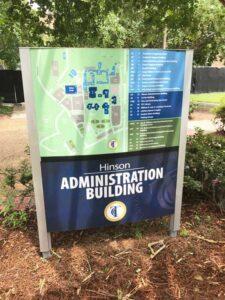 Stepping onto a university or college campus can be an exhilarating experience, but it can also be overwhelming for newcomers and visitors. With sprawling grounds, numerous buildings, and a multitude of departments, navigating these educational institutions can sometimes feel like embarking on a labyrinthine adventure. This is where the humble, yet indispensable tool of signage plays a pivotal role. Clear, informative, and strategically placed signage serves as a guiding light, ensuring that students, faculty, staff, and guests can effortlessly find their way around campus. In this article, we explore the significance of signage on college and university campuses and how it contributes to a seamless and enriching educational experience.
Stepping onto a university or college campus can be an exhilarating experience, but it can also be overwhelming for newcomers and visitors. With sprawling grounds, numerous buildings, and a multitude of departments, navigating these educational institutions can sometimes feel like embarking on a labyrinthine adventure. This is where the humble, yet indispensable tool of signage plays a pivotal role. Clear, informative, and strategically placed signage serves as a guiding light, ensuring that students, faculty, staff, and guests can effortlessly find their way around campus. In this article, we explore the significance of signage on college and university campuses and how it contributes to a seamless and enriching educational experience.
Enhancing Wayfinding and Navigation
The primary purpose of signage on campuses is to facilitate wayfinding and navigation. By providing clear directional information, signage helps individuals find their desired buildings, classrooms, departments, administrative offices, libraries, dining facilities, and other important destinations. Well-designed and strategically placed signs act as beacons of guidance, alleviating confusion and reducing the time spent searching for specific locations. This enhances efficiency, minimizes stress, and promotes punctuality among students and staff.
Fostering Safety and Security
Universities and colleges prioritize the safety and security of their campus community. Signage plays a crucial role in this aspect by conveying vital information related to emergency procedures, evacuation routes, fire exits, and safety guidelines. By prominently displaying this information, signage ensures that everyone on campus remains informed and prepared to respond swiftly in case of any potential threats or emergencies. Additionally, directional signage also assists emergency responders in quickly locating and reaching the required destinations.
 Promoting Campus Identity and Branding
Promoting Campus Identity and Branding
Signage acts as an extension of the college’s brand identity. By incorporating the institution’s logo, colors, and visual elements, signage on campus reinforces a sense of belonging and unity among the community. Consistency in design and branding creates a cohesive visual experience and helps strengthen the institution’s reputation. Signage can also be used to highlight campus achievements, showcase upcoming events, and promote student clubs and organizations, contributing to a vibrant and engaged campus atmosphere.
Supporting Accessibility and Inclusivity
Creating an inclusive environment on campus is of utmost importance. Signage plays a crucial role in ensuring accessibility for individuals with disabilities. By incorporating Braille, tactile lettering, and contrasting colors, signage becomes more readable and navigable for those with visual impairments. Additionally, clear signage with well-defined symbols and icons helps individuals who may have language barriers or difficulties in comprehension. When designed with accessibility in mind, signage enhances the overall campus experience for all members of the community.
Enhancing Orientation and Onboarding
For incoming students and new faculty, the first few days on campus can be overwhelming. Signage helps ease this transition by providing clear guidance during the orientation and onboarding process. Orientation signage can include maps, directions to key locations, and informational signs that answer frequently asked questions. By familiarizing newcomers with campus layout and facilities, signage plays a vital role in creating a welcoming and inclusive atmosphere, ultimately enhancing the overall student and employee experience.
 In conclusion, the significance of signage on university and college campuses cannot be emphasized enough. Its role in enhancing wayfinding, promoting safety, fostering campus identity, supporting accessibility, and facilitating a seamless orientation process is paramount. Signage acts as a steadfast companion for students throughout their educational journey, from their first steps on campus to their graduation day.
In conclusion, the significance of signage on university and college campuses cannot be emphasized enough. Its role in enhancing wayfinding, promoting safety, fostering campus identity, supporting accessibility, and facilitating a seamless orientation process is paramount. Signage acts as a steadfast companion for students throughout their educational journey, from their first steps on campus to their graduation day.
Recognizing the importance of well-designed and strategically placed signage, universities and colleges should invest in its development. By doing so, they can create an environment that is not only functional but also inviting for all members of the campus community. Clear, informative, and visually appealing signage contributes to a positive campus experience, allowing individuals to navigate with ease, feel secure, and foster a sense of belonging.
In the grand tapestry of the educational landscape, signage may seem like a small thread. However, its impact on campus life is undeniable. So let us embrace the power of signage, embracing its potential to transform university and college campuses into thriving and vibrant centers of knowledge, exploration, and community.
